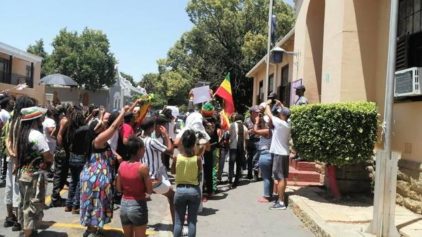Oscar Pistorius received a boost in his murder trial Wednesday when testimony from a South African detective indicated he found no inconsistencies in the claims by the double amputee sports hero who shot and killed his girlfriend, Reeva Steenkamp on Valentine’s Day.
Pistorius, nicknamed Blade Runner, said he thought a burglar was in the bathroom of his home when he shot four times through the door, three times hitting Steenkamp, who died at the scene. Prosecutors claim he murdered her in an angry rage in a case that has captured the attention of the country and much of the world.
Under cross-examination, Detective Warrant Officer Hilton Botha acknowledged that the witness who allegedly overheard the argument was more than 650 yards from Pistorius’ house — nearly 2,000 feet or four city blocks in Pistorius’ gated community in the suburbs of South Africa’s capital, Pretoria.
Later, Botha said the distance was much closer. But confusion reigned for much of his testimony. At one point Botha said officers found syringes and steroids in Pistorius’ bedroom. Prosecutor Gerrie Nel quickly interjected that the drugs were actually testosterone.
Pistorius said in an affidavit read in court that he and Steenkamp, a 29-year-old model and budding reality TV star who was cremated Tuesday, had gone to bed and that when he awoke during the night he detected what he thought was an intruder in the bathroom. He testified that he grabbed his 9 mm pistol and fired into the bathroom door, only to discover later to his horror that he had shot his girlfriend.
Botha said: “I believe that he knew that Reeva was in the bathroom and he shot four shots through the door.”
Nel displayed a plan of the bedroom and bathroom in court that showed Pistorius had to walk past his bed to get to the bathroom and could not have done so without realizing that Steenkamp was not in the bed.
“There’s no other way of getting there,” Nel said.
Botha said the trajectory of the bullets showed the gun was fired pointed down and from a height. This seems to conflict with Pistorius’ statement Tuesday, when the athlete said that he did not have on his prosthetics and was on his stumps and feeling vulnerable because he was in a low position when he opened fire.
But asked if the police found anything inconsistent with the version of events presented by Pistorius, Botha responded that they had not. He later said nothing contradicted the police’s version either.
Officers also found .38-caliber pistol rounds in a safe, which Botha said Pistorius owned illegally and for which he said the athlete would be charged. However, Botha also acknowledged investigators didn’t take photographs of the ammunition and let Pistorius’ supporters at the crime scene take them away.
Botha said the holster for the 9 mm pistol was found under the left side of the bed, the side on which Steenkamp slept. He also implied it would have been impossible for Pistorius to get the gun without knowing if Steenkamp was there. Pistorius attorney Barry Roux later argued that Pistorius had suffered an injury to his right shoulder and wore a “medical patch” the night of the killing and slept on the left side of the bed.
Steenkamp was shot in the head over her right ear and in her right elbow and hip, breaking her arm and hip, Botha said. However, Roux later asked Botha if Steenkamp’s body showed “any pattern of defensive wounds.” The detective said no.


